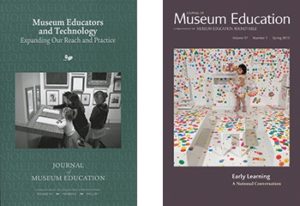A Visual History of the JME
In “looking back” on my own history, I realize my interest in the visual design of the Journal of Museum Education should come as no surprise. I’ve always seemed to find a design-focus in my professional and volunteer work. And personal; I married a designer. So, when I learned the JME was mid-redesign when I joined the Museum Education Roundtable (MER) Board in 2011, I naturally joined the effort.
The JME was getting a makeover inside and out for its 37th volume, to be released in spring 2012. For over 30 years each issue of the journal had been guest-edited with a specific focus on a single topic. To better accommodate the many voices wanting to share their research and best practices, the Editors-in-Chief, Cynthia Robinson and Tina Nolan, had decided to continue this thematic tradition while opening the back section of the journal to single submission articles.
To mark the introduction of this new format, the team at Left Coast Press, our publishing partner at that time, offered us the opportunity to simultaneously revamp the visual design of the JME—new fonts, new logotype, and a full color cover. This is where we were, and this is where we landed:

We were particularly excited about the full color cover. We work in a dynamic, engaging, and visual field; with color cover images on the outside of the JME, we finally could mirror the vitality and relevance of the articles printed inside. In fact, I felt this was such an important opportunity to raise the profile of the journal that I offered my time to serve as cover photo editor.
So, every few months I exchange emails with the upcoming issue’s guest-editor and we brainstorm how to visually represent their theme on the cover. Sometimes it’s easy, as with the very first cover (v.37, n.1), and a case study or museum program featured in the issue provides a dynamic image. Sometimes organizations, like the Columbus Museum of Art (v.39, n.2), take the challenge and run with it, working together to create a work of original art for the cover. And sometimes I find myself tracking down a famous Pop artist in New Zealand to ask his permission to use one of his works (v.39, n.1). It’s never boring. Beyond a good idea, our biggest challenge is finding an image we can use for free, as we do not have an art budget for covers.
The second issue I worked on (v.37, n.2) critically examined the professionalization of the field of museum education beginning in the late 1960s. In his article “Professional Organizations and the Professionalizing of Practice: The Role of MER, EdCom, and the NAEA Museum Division, 1969-2002,” Elliott Kai-Kee provided an overview of the history of our profession through the organizations formed to support and promote our work and the various books, journals, and reports published during the this thirty-year period.
 I had read many of these publications in graduate school and had a strong visual memory of their cover art—all those hours “studying,” I suppose. I decided to gather together as many of these publications as possible to create a visual timeline of our field using the covers of the most important publications—including, of course, the JME.
I had read many of these publications in graduate school and had a strong visual memory of their cover art—all those hours “studying,” I suppose. I decided to gather together as many of these publications as possible to create a visual timeline of our field using the covers of the most important publications—including, of course, the JME.
I contacted the MER office manager and a few days later a FedEx box arrived filled with selections from the JME archive. I was still new to the MER Board and digging through the pile was, well, awe-inspiring. From the journal’s humble beginning in 1973 as Roundtable Reports, a series of five reports on work funded by an NEA grant, through the Editorial Board’s decision in 1985 to rename the publication the Journal of Museum Education in an effort to further legitimize the work of educators in museums, the JME provides a fascinating glimpse into the evolution of our field. It grounds us, and our practice.
In pulling together this cover image, I scanned many more issues of the JME than I could use. They are quite fun to look at. So, I offer you this Tumblr feed: A Visual History of the JME as a brief glimpse into the visual history of the JME. What are your favorites? Do you have thoughts on the journal as a physical object—its design, its covers? Do you have a stash of crumbling Roundtable Reports on your bookshelf? Add your thoughts and memories in the comments below. And be sure to join MER if you want to see what we pull together for the next JME cover image—and to read the thought-provoking and informative articles inside.
Elisabeth Nevins is the principal of Seed Education Consulting in Boston, working with museums and historic sites to create engaging and relevant learning experiences for visitors. She serves on the Board of the Museum Education Roundtable and as a reviewer and cover photo editor for the Journal of Museum Education. She tweets as @seededucation.

